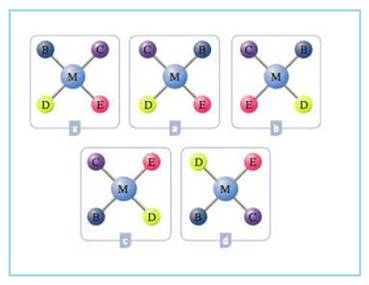
Concept explainers
Interpretation:
Following are the molecular models of complexes –

Figure 1
From the given molecular models of complexes the mirror images of the complex X has to be identified.
Concept Introduction:
Co-ordination compounds exhibit structural isomerism and stereoisomerism. Stereoisomerism deals with three dimensional spatial arrangements of atoms or groups of a molecule. There are two types of stereoisomerism – Geometric isomerism and optical isomerism.
A cis-isomer has two same ligands lying adjacent to each other whereas a trans-isomer has two same ligands lying opposite to each other.
In optical isomerism the isomer that rotates the plane of the polarized light in clockwise direction is termed as d-isomer and the isomer rotates the plane of the polarized light in anti-clockwise direction is l-isomer. These isomers are called optical isomers and they are non-superimposable mirror images.
Want to see the full answer?
Check out a sample textbook solution
Chapter 22 Solutions
General Chemistry
- Part II. two unbranched ketone have molecular formulla (C8H100). El-ms showed that both of them have a molecular ion peak at m/2 =128. However ketone (A) has a fragment peak at m/2 = 99 and 72 while ketone (B) snowed a fragment peak at m/2 = 113 and 58. 9) Propose the most plausible structures for both ketones b) Explain how you arrived at your conclusion by drawing the Structures of the distinguishing fragments for each ketone, including their fragmentation mechanisms.arrow_forwardPart V. Draw the structure of compound tecla using the IR spectrum Cobtained from the compound in KBr pellet) and the mass spectrum as shown below. The mass spectrum of compound Tesla showed strong mt peak at 71. TRANSMITTANCE LOD Relative Intensity 100 MS-NW-1539 40 20 80 T 44 55 10 15 20 25 30 35 40 45 50 55 60 65 70 75 m/z D 4000 3000 2000 1500 1000 500 HAVENUMBERI-11arrow_forwardTechnetium is the first element in the periodic chart that does not have any stable isotopes. Technetium-99m is an especially interesting and valuable isotope as it emits a gamma ray with a half life ideally suited for medical tests. It would seem that the decay of technetium should fit the treatment above with the result In(c/c) = -kt. The table below includes data from the two sites: http://dailymed.nlm.nih.gov/dailymed/druginfo.cfm?id=7130 http://wiki.medpedia.com/Clinical: Neutrospec_(Technetium_(99m Tc)_fanolesomab). a. b. C. Graph the fraction (c/c.) on the vertical axis versus the time on the horizontal axis. Also graph In(c/c.) on the vertical axis versus time on the horizontal axis. When half of the original amount of starting material has hours fraction remaining disappeared, c/c = ½ and the equation In(c/c.) = -kt becomes In(0.5) = -kt1/2 where t₁₂ is the half life (the time for half of the material to decay away). Determine the slope of your In(c/c.) vs t graph and…arrow_forward
- Please correct answer and don't use hand ratingarrow_forward1. a) Assuming that an atom of arsenic has hydrogen-like atomic orbitals, sketch the radial probability plots for 4p and 4d orbitals of S atom. Indicate angular and radial nodes in these orbitals. (4 points) b) Calculate Zeff experienced by and electron in 4p AO's in a arsenic atom. Use Slater rules that were discussed in lecture. (3 points)arrow_forwardNonearrow_forward
 Chemistry: The Molecular ScienceChemistryISBN:9781285199047Author:John W. Moore, Conrad L. StanitskiPublisher:Cengage Learning
Chemistry: The Molecular ScienceChemistryISBN:9781285199047Author:John W. Moore, Conrad L. StanitskiPublisher:Cengage Learning Chemistry: Principles and PracticeChemistryISBN:9780534420123Author:Daniel L. Reger, Scott R. Goode, David W. Ball, Edward MercerPublisher:Cengage Learning
Chemistry: Principles and PracticeChemistryISBN:9780534420123Author:Daniel L. Reger, Scott R. Goode, David W. Ball, Edward MercerPublisher:Cengage Learning Principles of Modern ChemistryChemistryISBN:9781305079113Author:David W. Oxtoby, H. Pat Gillis, Laurie J. ButlerPublisher:Cengage Learning
Principles of Modern ChemistryChemistryISBN:9781305079113Author:David W. Oxtoby, H. Pat Gillis, Laurie J. ButlerPublisher:Cengage Learning Chemistry: Principles and ReactionsChemistryISBN:9781305079373Author:William L. Masterton, Cecile N. HurleyPublisher:Cengage Learning
Chemistry: Principles and ReactionsChemistryISBN:9781305079373Author:William L. Masterton, Cecile N. HurleyPublisher:Cengage Learning ChemistryChemistryISBN:9781305957404Author:Steven S. Zumdahl, Susan A. Zumdahl, Donald J. DeCostePublisher:Cengage Learning
ChemistryChemistryISBN:9781305957404Author:Steven S. Zumdahl, Susan A. Zumdahl, Donald J. DeCostePublisher:Cengage Learning Chemistry: An Atoms First ApproachChemistryISBN:9781305079243Author:Steven S. Zumdahl, Susan A. ZumdahlPublisher:Cengage Learning
Chemistry: An Atoms First ApproachChemistryISBN:9781305079243Author:Steven S. Zumdahl, Susan A. ZumdahlPublisher:Cengage Learning





